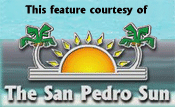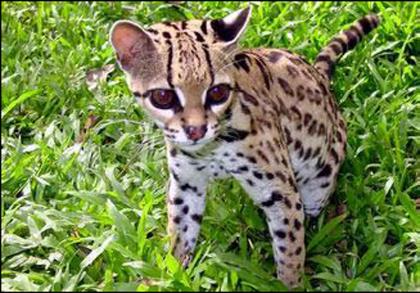
|
 The Ocelot

 Ocelots belong to the family Felidae,
which includes 36 species of
cats. Ocelots are classified under the
genus Leopardus. Leopardus includes
three species of “small cats,” the ocelot,
margay and little spotted cat.
Felis pardalis is still an accepted scientific
name for the ocelot. There are
eleven subspecies of ocelots. They
are distributed throughout Mexico,
Central and South America to northern
Argentina, with remnant populations
still in the southwestern United
States. The ocelot inhabits a wide
range of habitats. It can be found in
tropical forests, savannah grasslands,
and dense thorn scrub.
Ocelots belong to the family Felidae,
which includes 36 species of
cats. Ocelots are classified under the
genus Leopardus. Leopardus includes
three species of “small cats,” the ocelot,
margay and little spotted cat.
Felis pardalis is still an accepted scientific
name for the ocelot. There are
eleven subspecies of ocelots. They
are distributed throughout Mexico,
Central and South America to northern
Argentina, with remnant populations
still in the southwestern United
States. The ocelot inhabits a wide
range of habitats. It can be found in
tropical forests, savannah grasslands,
and dense thorn scrub.
The ocelot can be found in a variety
of habitats in Belize and is the
most commonly seen of all the cats
in the country. The Belizean name for
the ocelot is the same as the margay
“tiger cat”. The name “ocelot”
comes from the Mexican Aztec word
“tlalocelot” meaning field tiger.
The ocelot was once a common
animal in its region, but has been
hunted to near extinction for its beautiful
fur. Its fur resembles that of a
jaguar and was once regarded as particularly
valuable. It was so popular
the ocelot remains one of the most
well known of the small wildcats.
Several hundreds of thousands of ocelots
were killed for their fur; therefore
this cat is now an endangered
species in many countries.
The ocelot is often referred to as
one of the most beautiful of cats, with
a graceful, strong body and long, powerful
legs. The short, slick coat is
creamy yellow marked with rosettes
and spots which tend to run parallel
to the sides of its body. The head has
bold, black spots and bars. The tail is
ringed and tipped with black. It is a
medium sized cat weighing from 12
to 30 pounds, and its length varies
from 30 to 41 inches. They have an
extraordinary sense of vision at low
light levels, as well as an acute sense

The ocelot has a graceful, strong body and long, powerful legs. It is a medium sized cat and has an extraordinary sense of
vision at low light levels, as well as an acute sense of smell and hearing. |
of smell and hearing. The average life
span is about ten to thirteen years in
the wild and up to twenty years in captivity.
It is not surprising that ocelots are
nocturnal hunters, although they will
sometimes venture out during the day
for a drink of water. During the night,
they tend to hunt along open trails,
while during the day they stay hidden
within the deeper bush. Ocelots do
most of their hunting on the ground,
their slender bodies enabling them to
capture prey in the thickest thorn
brush. Although they are mainly
ground hunters, ocelots will expertly
climb trees for birds or squirrels and
can easily swim in rivers and ponds
for fish. Its diet consists of small to
medium sized animals, such as iguanas,
rabbits, mice, birds, rats, guinea
pigs, monkeys, hares, small deer,
peccaries and sometimes poultry.
Ocelots are solitary animals who
occupy small, exclusive areas of land,
approximately 20 square miles (52 sq
km). They mark their territory with
urine and scent markings. Male ocelot
ranges are often larger than that
of a female. Male ocelots avoid other
male ocelot territories; however, they
will overlap into other female ranges.
Although individuals roam and hunt
separately, research indicates that
ocelots will frequently contact one
another and probably maintain a network
of social ties. During the day,
when they rest in trees or other dense
foliage, they will occasionally share
their spot with another ocelot of the
same gender. Ocelots communicate
by meows, and during courtship,
yowls in a manner similar to that of
a domestic cat.
Ocelots sexually mature at about
20 to 24 months in age. Mating in the
wild or in captivity may occur at any
time, usually once or twice a year.
Gestation lasts about 70 days. Female
ocelots usually give birth to one to
four kittens, averaging two young per
litter. Females give birth in well protected
areas such as a dense thorn
thicket or hollow tree. Ocelot kittens
are highly reliant upon their mother
for survival, and the mother cares for
her young alone. When it becomes
necessary for her to hunt, the mother
will conceal the litter in a den surrounded
by thick shrubs. Kittens are
dependent on their mother for five to
six months. At around six months of
age, kittens start to practice hunting
techniques alongside their mother, but
they will not hunt alone until 18 to 24
months of age. By that time, they are
ready to leave their mother’s side to
look for their own territory and mate.
The U.S. Fish and Wildlife Service
lists the ocelot as Endangered. 

Ocelot kittens are highly reliant upon their mother for survival and are dependent
on their mother for five to six months. At around six months of age, kittens
start to practice hunting techniques alongside their mother. |
They are listed by CITES (the Convention
on International Trade in Endangered
Species of Wild Fauna and
Flora) as Appendix I. IUCN (the International
Union for the Conservation
of Nature and Natural Resources)
lists the ocelot as Least Concern.
Ocelots are protected by national
legislation over most of their
range. Only Peru still allows hunting,
and only Ecuador, El Salvador
and Guyana offer no protection. Ocelots
are primarily threatened due to
loss of habitat through deforestation,
although they seem to adapt to environmental
changes easier than other
animals in their region.

Ocelot caught on camera in the Chiquibul. Photo from PhD student,
Lauren N. Watine, and the Program for Tropical Ecology and Conservation
Science (PTECS).
Click here to return to the main page for Caribbean Critters
|


 Ocelots belong to the family Felidae,
which includes 36 species of
cats. Ocelots are classified under the
genus Leopardus. Leopardus includes
three species of “small cats,” the ocelot,
margay and little spotted cat.
Felis pardalis is still an accepted scientific
name for the ocelot. There are
eleven subspecies of ocelots. They
are distributed throughout Mexico,
Central and South America to northern
Argentina, with remnant populations
still in the southwestern United
States. The ocelot inhabits a wide
range of habitats. It can be found in
tropical forests, savannah grasslands,
and dense thorn scrub.
Ocelots belong to the family Felidae,
which includes 36 species of
cats. Ocelots are classified under the
genus Leopardus. Leopardus includes
three species of “small cats,” the ocelot,
margay and little spotted cat.
Felis pardalis is still an accepted scientific
name for the ocelot. There are
eleven subspecies of ocelots. They
are distributed throughout Mexico,
Central and South America to northern
Argentina, with remnant populations
still in the southwestern United
States. The ocelot inhabits a wide
range of habitats. It can be found in
tropical forests, savannah grasslands,
and dense thorn scrub.



